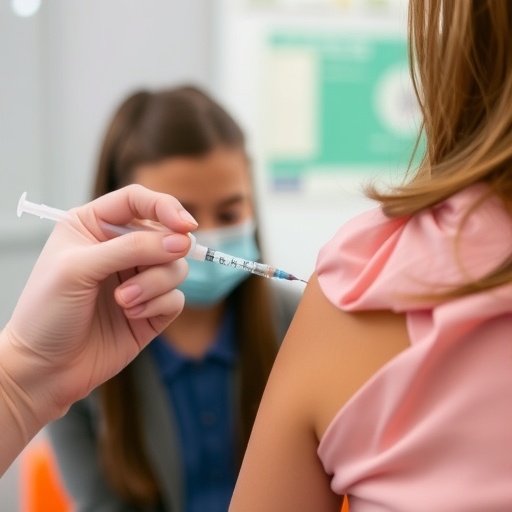
Adolescent Psychedelic Use and Mental Health Linked to Personality Traits: A Groundbreaking National Study Reveals New Insights
In a compelling new study set to disrupt our understanding of adolescent behavior and mental health, researchers have uncovered significant associations between the use of psychedelic substances among teenagers and their underlying personality profiles. This comprehensive national study sheds light on the multifaceted interplay between adolescent mental health outcomes, personality traits, and psychedelic drug use, emphasizing the importance of psychological individuality in the context of substance use during a critical developmental period.
The research, conducted by Sjöström, Claesdotter-Knutsson, Gripe, and colleagues, represents one of the most representative investigations into adolescent psychedelic consumption patterns and associated mental health responses. This landmark study harnessed robust national-level datasets, enabling a nuanced analysis of how youth personality dimensions interact with their experiences of psychedelics and subsequent psychological trajectories. As psychedelic substances gain increasing attention both in popular culture and clinical research, understanding their impact on the vulnerable adolescent brain becomes paramount.
.adsslot_bh5SEQgZRj{width:728px !important;height:90px !important;}
@media(max-width:1199px){ .adsslot_bh5SEQgZRj{width:468px !important;height:60px !important;}
}
@media(max-width:767px){ .adsslot_bh5SEQgZRj{width:320px !important;height:50px !important;}
}
ADVERTISEMENT
Central to the study is the exploration of how specific personality traits may predispose or protect adolescents from both the appeal and psychological consequences of psychedelic use. Using well-validated personality assessment models, researchers identified correlations between traits such as openness to experience, neuroticism, extraversion, conscientiousness, and agreeableness, and the likelihood of psychedelic engagement. Individuals exhibiting elevated openness, for example, were more inclined to experiment with these substances, reflective perhaps of a broader quest for novel experiences or altered states of consciousness.
The study further elucidates how these personality components modulate mental health outcomes post-psychedelic use. Adolescents characterized by high neuroticism—a tendency toward emotional instability and anxiety—demonstrated a significantly different mental health profile following psychedelic experiences compared to their low-neuroticism peers. This suggests that personality not only influences the probability of use but also shapes the subjective and clinical consequences, potentially moderating susceptibility to adverse psychological effects or, conversely, therapeutic benefits.
Technically, the study employs advanced statistical modeling techniques including multivariate regression analyses and structural equation modeling to parse out the intricate relationships between variables. These methods allow for adjustment of confounding factors such as socio-demographic variables, polysubstance use, and family mental health history. The strength of such methodology ensures that the findings represent robust, generalizable knowledge rather than artifacts of non-representative sampling.
Intriguingly, the data reveal that adolescents with certain personality profiles might derive different psychological impacts from psychedelics—ranging from transient increases in anxiety or depressive symptoms to improved mood or cognitive flexibility. This heterogeneity challenges the simplistic dichotomy of harmful versus harmless use and suggests a spectrum of outcomes contingent on intrinsic psychological frameworks.
Additionally, the research situates its findings within a neurodevelopmental context, underscoring the complexity of adolescent brain maturation. During this period, structural and functional brain plasticity is heightened, rendering youth more sensitive to environmental influences including psychoactive substances. The interplay between psychedelics and developing neural circuits, in conjunction with personality-driven behavioral patterns, paints a detailed portrait of risk and resilience factors that govern adolescent mental health.
From a public health perspective, this study signals a crucial need for personalized prevention and intervention strategies. One-size-fits-all approaches may overlook the diversity of adolescent experiences and motivations related to substance use. Instead, integrating personality assessments could enhance the precision of educational campaigns, early detection of mental health disturbances, and tailored therapeutic responses.
Moreover, the ramifications extend beyond the individual, as adolescent psychedelic use intersects with familial, social, and cultural dynamics. The findings provoke a reevaluation of societal narratives surrounding drugs and young people, advocating for evidence-based dialogues that acknowledge complexity rather than perpetuate stigma.
The implications for clinical applications are equally profound. As research into psychedelics advances in adult psychiatric treatment—particularly for depression, PTSD, and substance use disorders—understanding the adolescent perspective and its psychological variability remains essential. The study’s insights could inform future trials and ultimately guide safe, ethical frameworks for therapeutic use in younger populations, should such avenues be explored.
Beyond mental health, personality-linked psychedelic use patterns may also influence academic performance, social relationships, and risk-taking behaviors. These broader psychosocial dimensions merit further exploration, and this study provides a foundational lens for multidisciplinary inquiry integrating psychology, psychiatry, neuroscience, and sociology.
Importantly, the authors caution against simplistic causal interpretations, emphasizing the cross-sectional nature of much of the data. While associations are robust, establishing definitive causal pathways between personality, psychedelic use, and mental health requires longitudinal tracking and experimental designs. This acknowledgment underlines scientific rigor and sets a roadmap for evolving research agendas.
Technological advances in neuroimaging and psychometrics will likely enhance future work, offering granular insights into the neurobiological correlates underpinning the observed phenomena. Such integration of cutting-edge tools promises to unravel mechanistic underpinnings and identify biomarkers predictive of outcomes, opening novel preventive and therapeutic horizons.
In an era where adolescent mental health challenges are mounting globally, alongside shifting attitudes toward psychoactive substances, this study’s revelations are both timely and consequential. They demand a calibrated response from policymakers, educators, clinicians, and researchers alike, seeking to optimize youth well-being in a complex pharmacopsychological landscape.
Ultimately, the work of Sjöström and colleagues marks a significant advance in our comprehension of adolescent psychedelic use’s nuanced interrelation with personality and mental health. By revealing the variegated human psyche’s role in modulating drug experiences and outcomes, they invite us into a more empathetic, scientifically grounded discourse on youth substance behaviors—one that champions personalization, balance, and informed understanding.
As the scientific community digests these findings, the potential for transforming public health strategies, mental illness prevention, and therapeutic innovation emerges powerfully. This study not only unearths critical psychobehavioral dynamics but also envisions a future where adolescent care is as individualized as the personalities it encompasses.
Subject of Research: Adolescent psychedelic use, personality traits, and mental health outcomes
Article Title: Adolescent Psychedelic Use and Mental Health Is Associated with User Personality: A Representative National Study on Drug Use
Article References: Sjöström, D.K., Claesdotter-Knutsson, E., Gripe, I. et al. Adolescent Psychedelic Use and Mental Health Is Associated with User Personality: A Representative National Study on Drug Use. Int J Ment Health Addiction (2025). https://doi.org/10.1007/s11469-025-01481-7
Image Credits: AI Generated
Tags: adolescent psychedelic useclinical implications of psychedelic use.correlations between personality and psychedelicsimpact of psychedelics on adolescentsmental health outcomes in teenagersnational study on adolescent behaviorpersonality profiles and drug usepersonality traits and mental healthpsychedelic substances and youth behaviorpsychological individuality in substance useresearch on adolescent substance consumptionvulnerability of adolescent brain





